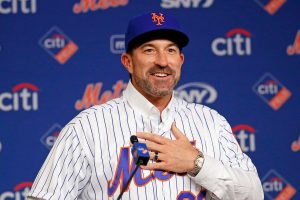By Peter Valentino

The Mets introduced their 21st manager on Monday: Mickey Callaway, the former pitching coach of the Cleveland Indians. At the podium, the 42-year-old showed great energy and excitement, eager to call and meet the new players. He let out his southern drawl for the New York media, showing a kind side that juxtaposed the intense Terry Collins. Callaway’s work speaks for itself, as he helped turn Corey Kluber from an unranked prospect into a Cy Young winner, as well as helping the Indians make the World Series in 2016. Initially, Mets fans seem happy with this signing, especially with Alex Cora ending up in Boston (in an admittedly better situation than the Mets) and the other candidate being former MLB manager Manny Acta. So with this hiring and everything that comes from it, where do the Mets go from here?
One of the more interesting aspects of this offseason is going to be what happens with Kevin Long. The hitting coach was the early favorite to be hired by the Mets before management decided to go in a different direction. He may bounce somewhere else, possibly taking a managing position with the rival Nationals or Phillies (although I think the front runner for both jobs is probably John Farrell). He hasn’t shared his reaction on Callaway’s hiring yet, but the ball is in his court as to whether or not he’ll be back.
Another aspect will be the direction of the team. In the press conference on Monday, the phrase “Trust the Process” was thrown around for a little bit, which isn’t good to hear for a team that wants to be competitive next year. If the team accepts rebuilding, Callaway is probably the right guy for it, but the media and the organization will have to be patient with him. The team signed him for three years, which is better than the one-year deal it signed Collins to in 2011. The vibe from the press conference did seem like they were going to be patient, but the New York media has always been quick to turn.
As for the team outlook, its bullpen got younger and better with the trades of Addison Reed, AJ Ramos and Curtis Granderson. This shows that the Mets aren’t entirely relying on their starting pitching to get by. The team, technically being a small-market organization, is following the “bombs and bullpen” strategy that plenty of rebuilding teams use to stay relevant. However, what differentiates them from other teams is the fact that they just might still have a few good starting pitchers if Noah Syndergaard, Steven Matz and Zack Wheeler, and maybe Matt Harvey, can come back and perform at the level that they did earlier in their careers. One of the more concerning factors is that the Mets did say that they were going to have a smaller payroll in 2018. Maybe the team will make one or two bigger named signings, such as getting another bat or a number-five starter (Bartolo? CC?), but mostly, the team will stick with what it has.
The team has a long way to go before the Mets fans and the rest of the baseball world can be convinced that it is a contender. It has its young manager, which is great for the long run, but as for 2018, the Mets will have to do a lot more this offseason than they did last winter.




































































































































































































